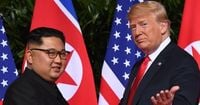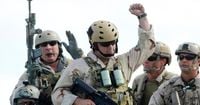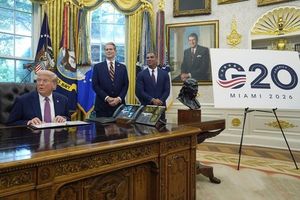In a revelation that has sent shockwaves through Washington and beyond, multiple major outlets including The New York Times, CNN, and The Daily Beast have reported on a secret U.S. Navy SEAL operation inside North Korea in 2019 that ended in disaster, with unarmed North Korean civilians killed and the mission’s objectives left unfulfilled. The classified mission, which came during high-stakes nuclear negotiations between President Donald Trump and North Korean leader Kim Jong Un, was intended to plant an electronic device to intercept Kim’s communications. Instead, it resulted in a deadly encounter, international secrecy, and a flurry of denials at the highest level of U.S. government.
According to The New York Times, the operation was undertaken by SEAL Team 6’s Red Squadron—the same elite unit that killed Osama bin Laden in 2011. The plan was as daring as it was risky: slip a nuclear-powered submarine into North Korean waters, deploy two stealth mini-subs with SEALs aboard, and swim to shore to install a covert listening device. This operation, requiring meticulous rehearsal in freezing waters and the use of specialized scuba gear, was greenlit by President Trump himself, sources told the Times. The timing was no accident—the go-ahead reportedly came just before Trump’s much-publicized Vietnam summit with Kim Jong Un in February 2019, a period when U.S. intelligence sought new ways to penetrate North Korea’s notoriously opaque regime.
The stakes could not have been higher. With human intelligence sources virtually impossible to plant inside North Korea, the device was seen as a potential game-changer—if it worked. But as the SEALs approached the North Korean coastline under cover of darkness, events quickly spiraled out of control. As reported by CNN and corroborated by The Daily Beast, the team encountered an unexpected North Korean fishing vessel. Lacking any way to communicate with mission commanders due to blackout protocols, and fearing imminent discovery, a senior SEAL opened fire, with others quickly joining in. All those aboard the boat—later determined to be unarmed civilians, reportedly diving for shellfish—were killed.
Details of what happened next are chilling. According to the Times, the SEALs attempted to hide the evidence, pulling the bodies into the water and puncturing their lungs with knives to ensure they would sink and not be discovered by North Korean authorities. The mission was aborted on the spot, with the listening device never planted. U.S. spy satellites later detected a surge in North Korean military activity in the area, but it remains unclear whether Pyongyang ever pieced together the true nature of the incident. North Korea has never publicly commented on the deaths, nor has it acknowledged the operation.
The operation was kept secret not only from the public but also from Congress. As NDTV and The Daily Beast both noted, the Trump administration did not notify key members of the congressional intelligence committees before or after the mission—a potential violation of federal law. The mission remained classified and unacknowledged until the recent spate of investigative reporting. Only in 2021, under the Biden administration, were key members of Congress briefed about the failed operation, following an internal investigation whose findings remain classified.
When confronted by reporters on September 5, 2025, President Trump repeatedly denied any knowledge of the mission. "I don’t know anything about it, no. I could look, but I know nothing about it," he told journalists in the Oval Office, according to CNN and Nexstar Media. "I’m hearing it now for the first time." Trump’s denials came despite multiple sources telling The New York Times that he personally authorized the mission during his first term. The White House and Pentagon have declined to comment on the reports, with the U.S. Special Operations Command and North Korea’s mission to the United Nations also remaining silent.
The secrecy surrounding the mission has prompted concern from within the U.S. government and military. The New York Times reported that dozens of individuals with knowledge of the operation—ranging from civilian officials to current and former military personnel—spoke to the paper on condition of anonymity. Their decision to come forward, they said, was motivated by a belief that failures in U.S. special operations are too often hidden from public scrutiny by government secrecy.
For the SEALs involved, the mission was the result of months of grueling preparation. As detailed by NDTV, the Red Squadron rehearsed extensively in frigid water, planning to ride for hours in four-degree Celsius conditions using heated suits and advanced scuba gear. The plan was to get in, plant the device, and get out without being detected—a testament to the extreme difficulty of gathering intelligence in North Korea, one of the world’s most isolated and tightly controlled states.
The broader context of the mission is a U.S.–North Korea relationship marked by swings between bellicose threats and unprecedented diplomacy. In 2017, Trump famously warned North Korea that it would face "fire and fury like the world has never seen" if it continued making threats against the U.S. By 2018 and 2019, however, the tone had shifted, with Trump and Kim exchanging letters and meeting at several summits, including Trump’s historic 20-step walk into North Korean territory. Yet despite these gestures, negotiations ultimately stalled, with North Korea resuming missile tests in May 2019 and the country now believed to possess around 50 nuclear warheads, according to The Daily Beast.
The fallout from the failed mission has also reignited scrutiny of Trump’s record as commander-in-chief. The Daily Beast referenced a 2017 Navy SEAL raid in Yemen, also approved by Trump, which resulted in the deaths of 30 civilians and a SEAL Team 6 member. Trump’s controversial comments about military service members and his sometimes fraught relationship with senior generals have only added fuel to the debate.
For now, the 2019 North Korea operation stands as a sobering reminder of the risks and complexities of covert action, especially in a world where the line between intelligence gathering and international crisis can be razor thin. The full details may remain classified for years, but the consequences—both human and strategic—are already rippling through the halls of power.





